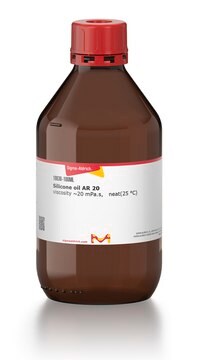85409
Silicone oil
Sinonimo/i:
Dimethyl polysiloxane
Autenticatiper visualizzare i prezzi riservati alla tua organizzazione & contrattuali
About This Item
Formula condensata:
[-Si(CH3)2O-]n
Numero CAS:
Numero MDL:
Codice UNSPSC:
12352100
NACRES:
NA.21
Prodotti consigliati
Densità del vapore
>1 (vs air)
Livello qualitativo
Tensione di vapore
<5 mmHg ( 25 °C)
5 mmHg ( 20 °C)
Stato
oil
Indice di rifrazione
n20/D 1.403 (lit.)
n20/D 1.406
Viscosità
100 mPa.s(20 °C)
P. ebollizione
>140 °C/0.002 mmHg (lit.)
Densità
0.967 g/mL at 20 °C
Cerchi prodotti simili? Visita Guida al confronto tra prodotti
Descrizione generale
Silicone oil is typically used for oil baths in research labs for reactions that require heating/reflux temperatures in the range of -50°C to +200°C. Oil baths provide more uniform heat in comparison to other heating devices.
Silicone oil is useful for the preparation of oil baths having a temperature in the range of -50°C to +200°C.
Applicazioni
Silicone oil has been used for the protection of carbon steel alloy samples in a study. Silicone oil has also been used as a heat reservoir during NMR (Nuclear Magnetic Resonance) analysis.
Codice della classe di stoccaggio
10 - Combustible liquids
Classe di pericolosità dell'acqua (WGK)
WGK 1
Punto d’infiammabilità (°F)
214.0 °F - closed cup
Punto d’infiammabilità (°C)
101.1 °C - closed cup
Dispositivi di protezione individuale
Eyeshields, Gloves
Scegli una delle versioni più recenti:
Possiedi già questo prodotto?
I documenti relativi ai prodotti acquistati recentemente sono disponibili nell’Archivio dei documenti.
I clienti hanno visto anche
Low-temperature atomic layer deposition of Al2O3 thin coatings for corrosion protection of steel: surface and electrochemical analysis.
Diaz B, et al.
Corrosion Science, 53(6), 2168-2175 (2011)
M Findeisen et al.
Magnetic resonance in chemistry : MRC, 45(2), 175-178 (2006-12-13)
Most established NMR thermometers rely on temperature-dependent chemical shift differences measured from samples that are either neat or concentrated solutions (e.g. ethylene glycol, methanol). These are unsuitable for modern cryoprobes on account of strong radiation damping resulting from the high
Tindaro Ioppolo et al.
Journal of visualized experiments : JoVE, (71)(71), e50199-e50199 (2013-02-15)
Optical modes of dielectric micro-cavities have received significant attention in recent years for their potential in a broad range of applications. The optical modes are frequently referred to as "whispering gallery modes" (WGM) or "morphology dependent resonances" (MDR) and exhibit
Benjamin R Schudel et al.
Lab on a chip, 13(5), 811-817 (2013-01-31)
RNA interference (RNAi) is a powerful tool for functional genomics with the capacity to comprehensively analyze host-pathogen interactions. High-throughput RNAi screening is used to systematically perturb cellular pathways and discover therapeutic targets, but the method can be tedious and requires
M Brun et al.
Conference proceedings : ... Annual International Conference of the IEEE Engineering in Medicine and Biology Society. IEEE Engineering in Medicine and Biology Society. Annual Conference, 2012, 6281-6284 (2013-02-01)
This paper demonstrates the potential use of a new microfluidic device embedding thick electrodes for cell lysis and cell separation applications. The system consists of a microfluidic channel featuring conductive walls made of a polydimethylsiloxane (PDMS) matrix mixed with carbon
Il team dei nostri ricercatori vanta grande esperienza in tutte le aree della ricerca quali Life Science, scienza dei materiali, sintesi chimica, cromatografia, discipline analitiche, ecc..
Contatta l'Assistenza Tecnica.



